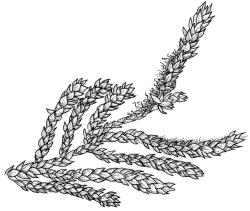Plants rather small to medium-sized, forming dull and dark mats. Stems freely and irregularly branched. Stem and branch leaves similar, usually erect when dry and erect-spreading or spreading when moist, mostly ovate to ovate-lanceolate, or rarely oblong-lingulate, acute, acuminate, or rarely rounded at apex, entire or rarely toothed to spinose, plane or reflexed at margins; mid laminal cells isodiametric or occasionally elongate, firm-walled, smooth, mammillose or variably papillose. Costa single and well-developed or rarely short and double. Paraphyllia sometimes present, rarely numerous.
Sexuality variable. Inflorescences lateral. Perichaetial leaves differentiated. Setae elongate, smooth; capsules erect or rarely ± curved, cylindric or oblong-cylindric, smooth; annulus sometimes differentiated; operculum conic and blunt to rostrate. Peristome double; exostome teeth lanceolate to linear-lanceolate, variably ornamented or smooth; endostome usually reduced, usually with a basal membrane, segments present but irregular and cilia none or rudimentary. Calyptra cucullate, usually smooth, naked. Spores spherical, smooth or papillose.
The distinctions between the Leskeaceae and the Thuidiaceae are discussed by Buck & Crum (1990), and their conclusions are reflected in their treatment of the family for Mexico (Crum & Buck 1994). In turn this treatment largely accords with the concept of the Leskeaceae presented by Goffinet et al. (2009). As most of the genera are predominantly distributed in the northern hemisphere and unfamiliar to me, I have used Crum & Buck (1994) in preparing the family description presented above.
Goffinet et al. (2009) recognised 21 genera in the Leskeaceae; of these only Lindbergia and Pseudoleskea are found in N.Z. A strong tendency for erect capsules and reduced endostomes is a feature of this family.
When fruiting, additional features (e.g., ornamentation of exostome teeth and degree of endostome development) should separate these genera, but the regional species of Lindbergia is not known with capsules.
| 1 | Laminal cells strongly and centrally mammillose on both surfaces in N.Z. species; leaves ovate to ovate-lanceolate in N.Z. species; propagula (branchlets) present in axils of upper leaves; plants not on limestone, coastal and known only from N Auckland L.D. | Lindbergia |
| 1' | Laminal cells obscurely bulging at upper end (prorate); leaves broadly ovate and decurrent in N.Z. species; propagula (branchlets) absent; plants usually on limestone, widespread in N.Z. | Pseudoleskea |
| Category | Number |
|---|---|
| Indigenous (Endemic) | 1 |
| Indigenous (Non-endemic) | 1 |
| Total | 2 |




